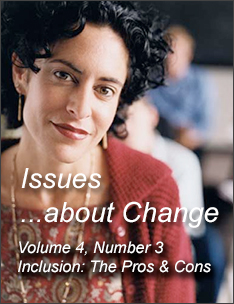Inclusion: The Pros and Cons
Introduction
Few issues in education generate more discussion, confusion, or apprehension than the topic of inclusion. It is an issue that has outspoken advocates on all sides, whether staunchly for, avowedly against, or somewhere in between. Certainly, for a school or district to change and accommodate a more inclusive approach to providing services to students with disabilities as well as a host of other "at-risk" students, and do it in a way that ensures the success of all, will require significant restructuring. Inclusion is more than reconfiguring special education services. It involves an "overhaul" of the entire educational system. Special education and regular education faculty/staff roles and relationships will change, as will the traditional rules under which "things" happen within the classroom, campus, and district. Therefore, understanding the issues and ramifications prior to undertaking such a restructuring effort will be useful.
For many, the concept of inclusion remains somewhat vague. What does inclusion actually mean? What does it look like? Is it the same as full inclusion or mainstreaming? What is wrong with special education the way it is now? What changes would need to be made to adopt a more inclusive approach for special education services? What are the overarching issues-the pros and cons? This installment of Issues ... about Change will investigate many of these issues surrounding inclusion. Specifically, a short historical synopsis of the development of special education services will be presented, followed by a clarification of terms. Philosophical, educational, and legal arguments for and against greater inclusion are also presented. The paper concludes with a short discussion of implications for educational practitioners and district policy makers. Finally, in addition to an extensive list of references cited in the article, a list of other resources is included below for those interested in further investigation.
Historical Background
Reynolds (1988) uses the term "progressive inclusion" to describe the evolution of services to those with various disabilities. He and others (Winzer, 1993; Stainback, Stainback, & Bunch, 1989b) point out that as the United States emerged as a nation, no educational services were available to people with disabilities. In the early 1800s, residential institutions, or asylums, began to emerge in order to accommodate those with hearing, visual, mental, or emotional impairments. Although access to those facilities was far from universal, such institutions remained the primary educational option for the disabled until special day schools came into fashion in the early 1900s. These allowed greater, more localized access and somewhat better services to individuals with disabilities.
During the 1950s and 1960s, parents of children with disabilities organized to pressure courts and legislatures for changes in educational services available to their children. They began to seek access to public schools as an issue of civil rights for those with disabilities. Among the results of these efforts was The Education for All Handicapped Children Act of 1975 (PL 94-142), which mandated that all children, regardless of disability, had the right to a free, appropriate education in the least restrictive environment. As a result, resource rooms and self-contained classrooms for those with disabilities expanded in public schools. PL 94-142 was updated in 1991 by the Individuals with Disabilities Education Act (IDEA).
In 1986, Madeleine Will, then-Assistant Secretary for the Office of Special Education and Rehabilitative Services (under the U.S. Department of Education), in an annual report regarding the status of special education programs, proposed what has been called the Regular Education Initiative. Citing concerns about some unintended negative effects of special education "pull-out" programs, her proposal suggested that greater efforts to educate mildly and moderately disabled students in the mainstream of regular education should be pursued (Will, 1986). Since then, support has grown for all students, including those with severe and profound disabilities, to be included and educated in classrooms with non-disabled peers, preferably in schools that they would attend if not disabled.
Determining the current status of educational placements of students with disabilities is difficult. Information varies depending upon the sources pursued. However, from the U.S. Department of Education's 16th Annual Report on Implementation of the IDEA (data from the 1991-1992 school year), it appears that about 35 percent of students with disabilities are attending school in regular classes. Of the remaining 65 percent, 36.3 percent receive special educational services in a resource room setting and 23.5 percent are in self-contained classes specifically tailored for students with disabilities. A little over 5 percent of students identified as needing special educational services receive them in settings outside the regular school setting (separate school, residential facility, homebound, or hospital).
Next Page: Toward a Definition of Inclusion

